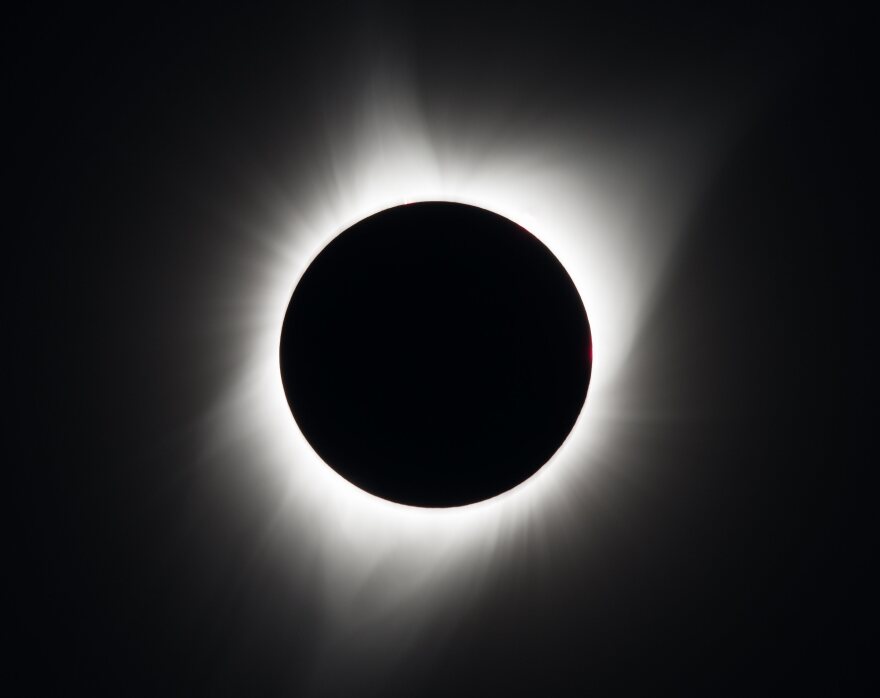Officials from communities in the path of totality are preparing for an influx of visitors to watch the upcoming solar eclipse. Tens of thousands of people are expected to visit the Adirondacks and northern Vermont beginning next weekend for the April 8th celestial event.
The upcoming total solar eclipse will cross a large swath of the eastern United States. It will enter New York state in Jamestown, travel over Buffalo, Rochester, Syracuse, the Adirondacks, and Plattsburgh. It then passes over Lake Champlain into Vermont.
This is the first time in known history that the Adirondacks has been in the path of totality during a solar eclipse. The Lake Placid-based Regional Office of Sustainable Tourism has been working with local communities and businesses to prepare. Chief Operating Officer Mary Jane Lawrence says hotels and short-term rentals are reporting heavy bookings for the eclipse.
“We’re seeing the majority of the occupancy Friday, starting check in Friday April 5th through Tuesday April 9th,” reported Lawrence. “We also know that locations that have made reservations or are taking reservations are at high demand. So the indicators that we are able to track have shown us that we are going to have a significant uptick in our region for visitors during the eclipse.”
Officials throughout the path of totality have been studying what happened immediately following the 2017 solar eclipse. In some areas, there were reports of traffic backups lasting 8 to 10 hours.
ROOST Director of Marketing Michelle Clement says the primary concern is traffic congestion immediately after the eclipse.
“Around 4:30 as the partial eclipse ends that’s when we’re going to see the greatest amount of traffic,” Clement said. “That’s the time when we are anticipating that it will be very slow-moving traffic, really localized congestion around those viewing areas. The other area of really heavy traffic is vehicles leaving trying to get back to I-87 the Northway, I-81. That is one area that is being watched and there may be potential rerouting if things do get backed up.”
Congestion following the eclipse is also a concern for planners in Burlington, Vermont. Officials there are expecting at least 50,000 people to visit the city for the eclipse. Burlington City Arts Event and Festival Director Zach Williamson says they are encouraging people to arrive early and stay late.
“Most models do show that if we see a large number of vehicles in the entirety of northern Vermont that I-89 from Exit 10 to the islands will get more crowded,” Williamson said. “The state and our data does show that the arrival is more sporadic. Some people are coming Friday, Saturday, Sunday. So we don’t think it’s going to be as bad leading up to the eclipse. It’s the after the eclipse which is a little bit more concerning. It could be a mass exodus although we are encouraging people to hang out in Burlington. So we’re doing our best to diffuse the exit strategy but it could start to get a little bit congested following the eclipse.”
Officials are urging people not to look directly at the sun and use solar eclipse glasses. Williamson noted that Burlington ordered 50,000 and is distributing them across the city.
“This is like wearing a welding mask. It is completely dark,” described Williamson. “Like if I put these on I cannot see anything out of them. That is surprising to some people. So, they are only needed when you are looking directly at the sun. The only time that you don’t need these on is during the totality period and we will make an effort at all of our sites to identify when that safety period is.”
The weather is also a concern as April can often be overcast. The Adirondack Sky Center and Observatory in Tupper Lake is working with NASA to study the eclipse and will be open for public events. President Seth McGowan says potential inclement weather should not deter anyone from watching the eclipse.
“I know everybody wants to see the corona,” said McGowan. “Beautiful experience, spiritual, the whole nine yards. But an overcast eclipse is equally as powerful. Even rain or snow. It’s still a very moving experience and they shouldn’t stay indoors or stay home. Still come to a totality. It’s still a great experience. Still wishing for good skies though!”
University of Vermont Space Grant Consortium NASA Program Administrator Ellen Brennan says not only is this eclipse unique because its path allows millions of people to observe it, but it’s also exciting researchers.
“The sun goes through an 11-year cycle of activity and right now we are at our peak level of activity,” noted Brennan. “Now when you block the sun out, like maybe with the moon during an eclipse, you get to look at the outer corona. That’s where all that cool stuff happens. That’s where we see flares. That’s where you get to actually view the activity of the sun. And for three minutes and fifteen seconds on April 8th we’re going to get to look at that and see it and at its highest activity ever for this cycle.”




